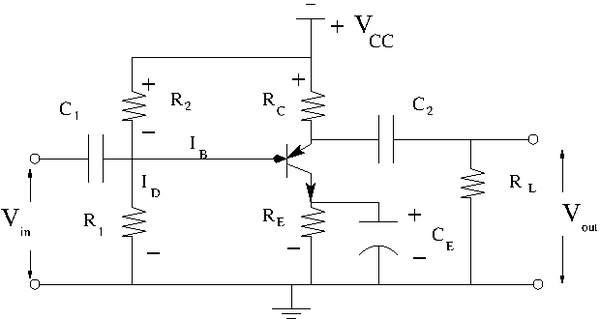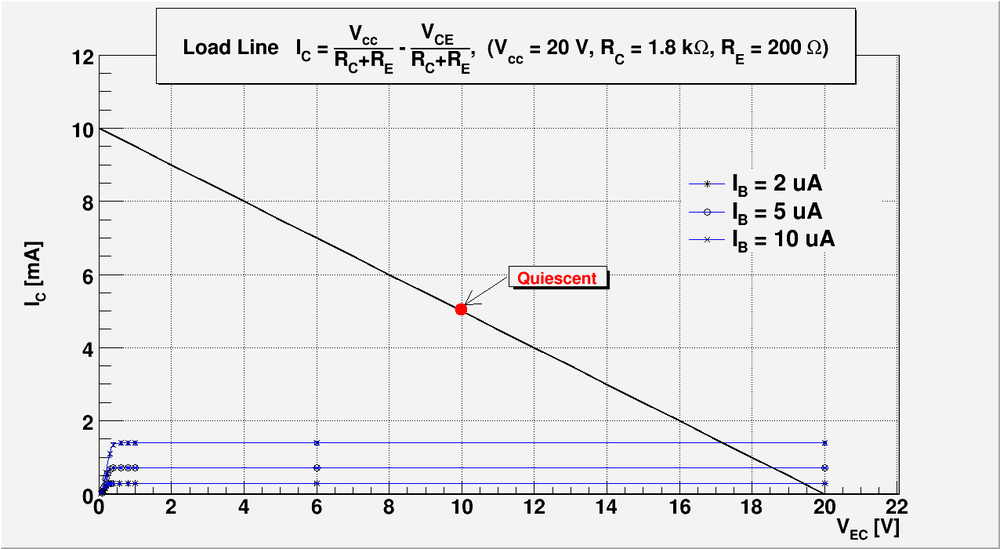Difference between revisions of "Lab 14 RS"
| Line 21: | Line 21: | ||
Let's <math>V_{CC} = 20\ V</math>, <math>R_E = 200 \Omega</math> and <math>R_C = 1.8\ k\Omega</math>. The load line equation becomes: | Let's <math>V_{CC} = 20\ V</math>, <math>R_E = 200 \Omega</math> and <math>R_C = 1.8\ k\Omega</math>. The load line equation becomes: | ||
| − | <math>I_C = \frac{V_{CC}}{R_E+R_C} + \frac{V_{ | + | <math>I_C = \frac{V_{CC}}{R_E+R_C} + \frac{V_{EC}}{R_E+R_C} = \frac{20\ V}{2\ k\Omega} + \frac{V_{CE}}{2\ k\Omega} = (10 + 0.5 \cdot V_{CE})\ mA</math> |
This load line pretty high and give me the wide range of amplification the input signal. | This load line pretty high and give me the wide range of amplification the input signal. | ||
| Line 27: | Line 27: | ||
| − | 3.)Draw a load line using the <math>I_{C}</math> -vs- <math>I_{ | + | 3.)Draw a load line using the <math>I_{C}</math> -vs- <math>I_{EC}</math> from the previous lab 13. Record the value of <math>h_{FE}</math> or <math>\beta</math>. |
[[File:Load Line 10mA.png | 1000 px]] | [[File:Load Line 10mA.png | 1000 px]] | ||
| Line 36: | Line 36: | ||
4.)Set a DC operating point <math>I^{\prime}_C</math> so it will amplify the input pulse given to you. Some of you will have sinusoidal pulses others will have positive or negative only pulses. | 4.)Set a DC operating point <math>I^{\prime}_C</math> so it will amplify the input pulse given to you. Some of you will have sinusoidal pulses others will have positive or negative only pulses. | ||
| + | |||
| + | I will set up my operating point in the middle of the load line: <math>I_C = 5\ mA</math>, <math>V_EC = 10\ mA</math>. So I will have the wide range of amplification the input signal <math>I_B = \pm 5\ mA</math> | ||
| + | |||
| + | |||
| + | |||
5.)Measure all DC voltages in the circuit and compare with the predicted values.(10 pnts) | 5.)Measure all DC voltages in the circuit and compare with the predicted values.(10 pnts) | ||
Revision as of 04:37, 20 March 2011
The Common Emitter Amplifier
Circuit
1.)Construct the common emitter amplifier circuit below according to your type of emitter.
2.)Calculate all the R and C values to use in the circuit such that
- a. Try and
- b. mA DC with no input signal
- c. V
- d. to prevent burnout
- e.
- f. mA
Let's , and . The load line equation becomes:
This load line pretty high and give me the wide range of amplification the input signal.
3.)Draw a load line using the -vs- from the previous lab 13. Record the value of or .
On the plot above I overlay me output lines from the previous lab report #13 and me load line I am going to use to construct amplifier. My based on my previous lab report #13
4.)Set a DC operating point so it will amplify the input pulse given to you. Some of you will have sinusoidal pulses others will have positive or negative only pulses.
I will set up my operating point in the middle of the load line: , . So I will have the wide range of amplification the input signal
5.)Measure all DC voltages in the circuit and compare with the predicted values.(10 pnts)
6.)Measure the voltage gain as a function of frequency and compare to the theoretical value.(10 pnts)
7.)Measure and at about 1 kHz and compare to the theoretical value.(10 pnts)
How do you do this? Add resistor in front of which you vary to determine and then do a similar thing for except the variable reistor goes from to ground.
8.)Measure and as a function of frequency with removed.(10 pnts)
Questions
- Why does a flat load line produce a high voltage gain and a steep load line a high current gain? (10 pnts)
- What would be a good operating point an an common emitter amplifier used to amplify negative pulses?(10 pnts)
- What will the values of , , and be if the transistor burns out resulting in infinite resistance. Check with measurement.(10 pnts)
- What will the values of , , and be if the transistor burns out resulting in near ZERO resistance (ie short). Check with measurement.(10 pnts)
- Predict the change in the value of if is increased from 10 to 50 (10 pnts)
- Sketch the AC equivalent circuit of the common emitter amplifier.(10 pnts)
Go Back to All Lab Reports Forest_Electronic_Instrumentation_and_Measurement

